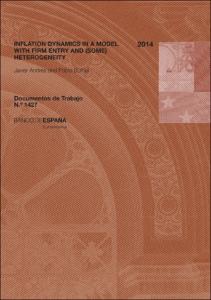Inflation dynamics in a model with firm entry and (some) heterogeneity
Autor
Fecha de publicación
5-dic-2014
Descripción física
49 p. : gráf., tab., fórmulas
Resumen
En este trabajo se analiza el impacto que la entrada endógena de empresas y la heterogeneidad en la productividad empresarial tienen sobre la respuesta de la inflación ante perturbaciones exógenas. Partiendo de un modelo DSGE estándar, se endogeniza el número de empresas y se permite que estas difieran en su nivel de productividad en el estado estacionario y, por lo tanto, en su tamaño. Se calibran las probabilidades de transición de las empresas entre distintos tamaños y de salida del mercado para reproducir las principales características de la distribución de empresas en España. A continuación se compara la respuesta de la inflación ante una perturbación de carácter tecnológico, del tipo de interés y de coste de entrada, entre otras. Se muestra que estructuras industriales en las que predominan empresas grandes (más productivas) generan una menor respuesta de la inflación ante perturbaciones exógenas
We analyse the incidence of endogenous entry and firm TFP-heterogeneity on the response of aggregate inflation to exogenous shocks. We build up an otherwise standard DSGE model in which the number of firms is endogenously determined and firms differ in their steady state level of productivity. This splits the industry structure into firms of different sizes. Calibrating the different transition rates, across firm sizes and out of the market we reproduce the main features of the distribution of firms in Spain. We then compare the inflation response to technology, interest rate and entry cost shocks, among others. We find that structures in which large (more productive) firms predominate tend to deliver more muted inflation responses to exogenous shocks
We analyse the incidence of endogenous entry and firm TFP-heterogeneity on the response of aggregate inflation to exogenous shocks. We build up an otherwise standard DSGE model in which the number of firms is endogenously determined and firms differ in their steady state level of productivity. This splits the industry structure into firms of different sizes. Calibrating the different transition rates, across firm sizes and out of the market we reproduce the main features of the distribution of firms in Spain. We then compare the inflation response to technology, interest rate and entry cost shocks, among others. We find that structures in which large (more productive) firms predominate tend to deliver more muted inflation responses to exogenous shocks
Publicado en
Documentos de Trabajo / Banco de España, 1427
Materias
Firm dynamics; Industrial structure; Inflation; Business cycles; Dinámica empresarial; Estructura industrial; Inflación; Ciclo económico; Fluctuaciones y ciclos económicos; Comportamiento y estructura de los mercados; Renta, empleo y precios; España
Aparece en las colecciones:












